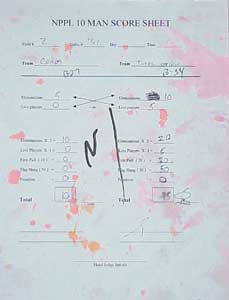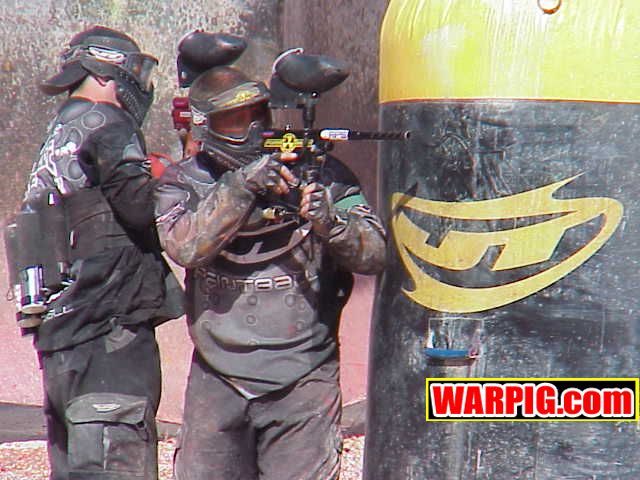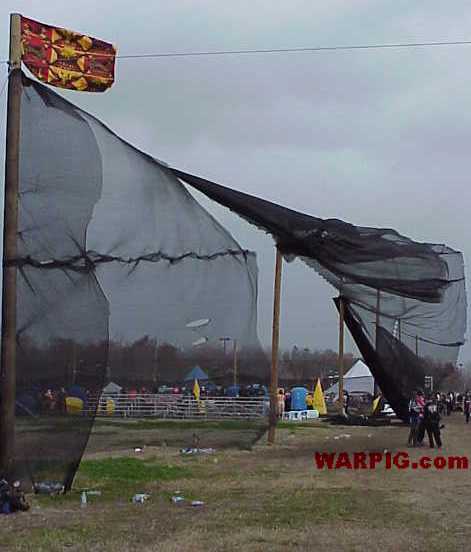
|
Tournaments in Style
by Dawn Mills - WARPIG.com
Every year I attend dozens of tournaments
for WARPIG.com. I'm the person who types in all the scores (as I've
done since 1996), I take all the photos of the event and I help the staff
of most events to handle scheduling snags and little things in organizing.
I've been involved in the top level tournaments from the NPPL to the smaller
events held in my local area. One of the things I've noticed throughout
my life in paintball is that tournaments are all run differently from another.
When I think about all that is needed to run a quality event, it's staggering
to me that they come off at all, especially when you factor in weather
and late flights and all the little things that come up when you put 60
to 1000 people together.
I have wanted to share some insights of
things that can be done well in advance of the big day to help alleviate
the trauma that can come from putting together a quality event.
Head Judge
Assign a person who has good leadership
skills, can write legibly, has good organizational abilities and a loud
voice to the position of head ref for each field. Often head refs
are chosen because they captain the team that is hired to ref. This
doesn't need to be the case - they need to be hired for their abilities.
His job is to keep teams on deck and handle any game flexing that needs
to be done if the fields get off-kilter. The head judge doesn't need
to be an amazing ref - instead he has make sure things run smoothly, and
have a thorough understanding of the rules you are using - and he needs
to be able to keep a cool temper when dealing with players who are throwing
a fit because they didn't like a call.
Banding & Chronoing
The head judge will chrono the on-deck
team on while the prior game is still being played. Have an extra
set of bands for each field -- that way the on-deck teams can be banded
prior to their taking the field, saving time.
Scoresheets
NCR paper is a little more expensive than
regular white paper, but could save in the long run with lost or mutilated
scoresheets. It's a nifty brand of paper that allows carbonless copies.
You can order it printed with the scoresheets with as many copies as you
like.  I
like the idea of a 4 sheet scoresheet. One for the field, one for
each team and one for the runner. That way if the runner has a coronary
midway through and gets rushed to the hospital, the field will still have
a valid form. And the beauty of the teams having their copies allows
them a momento for that smash game against the top pro team. So many
times teams have approached me asking for a copy of their scoresheet because
they'd like to keep it as a token of a really fantastic game. With
only one scoresheet, it's impossible to give them the game sheet since
they get archived to allow for statistical analysis of the games.
Issuing clipboards to each field is a big plus as well. Metal clip
boards that close up with storage space inside mean the score sheets can
be protected so they don't look tattered, torn, and covered in paint by
the time they reach the score table. I
like the idea of a 4 sheet scoresheet. One for the field, one for
each team and one for the runner. That way if the runner has a coronary
midway through and gets rushed to the hospital, the field will still have
a valid form. And the beauty of the teams having their copies allows
them a momento for that smash game against the top pro team. So many
times teams have approached me asking for a copy of their scoresheet because
they'd like to keep it as a token of a really fantastic game. With
only one scoresheet, it's impossible to give them the game sheet since
they get archived to allow for statistical analysis of the games.
Issuing clipboards to each field is a big plus as well. Metal clip
boards that close up with storage space inside mean the score sheets can
be protected so they don't look tattered, torn, and covered in paint by
the time they reach the score table.
Armband Judges
Their entire existence when not judging
is to collect dead and alive players after the game. That way the
armbands have less of a chance to wander off field. A big hold up
to large tournaments are lack of bands - a simple, inexpensive and relatively
easy thing to control. Often refs are new to the experience and really
don't know what to do between games aside from hang out. Giving someone
a responsibility can help give them a positive experience, and keep them
moving.
Reffing Supplies
When judges arrive for their daunting
dask of reffing games, they should receive a box (Big plastic boxes are
great) with the chronos they'll use, ref shirts, 2 sets of armbands, scoresheets
(pre labeled with team names if possible), pens, a set of tools for common
markers, a whistle to start and stop games, radios, a list of radio channels
to find the registration table, the Ultimate Judge, etc., towels and a
set of snacks and water for the first start of the morning. They
should also receive their reffing schedule. It needs to include the
time you want them at the field, what time to report to their particular
field and what time they can expect to receive drinks and food. Drinks
and food are probably the most critical aspect to having happy refs.
Without food, I've seen refs boycott games and at the least become less
effecient models of manhood. Part of the joy of being human means
we need fuel for our bodies - you must fuel your refs since they're the
people most seen as representing your event.
Signage
Clearly labeled signs can make or break
an event. Something hand lettered can certainly make the grade when
in a pinch, but if you want your event to stand out as a leader, have some
banners made (they'll cost maybe $25 a piece) for key items like Registration,
Food, Chrono Stations, Vendors Tent, Fire Lane, Air Tent, Players Tent,
etc. The beauty of the banners, they're reusable! Site maps
would also be highly useful for larger events, placed in key areas on a
kiosk.  One
thing that's always made me batty since we've gone to mostly bunker ball
style of play is that we're still labeling fields as Field 1, Field 2,
etc when it should be the PMI Field, National Paintball Supply Field, JT
Field, KAPP Field, etc. It's easy to distinguish a field at a glance
with company logos and bunker styles, like the infamous PMI field with
the giant PMI in the middle of the field, when using this method, not having
to determine if it's a random number. This also gives the sponsors
more coverage, which will make them happy! One
thing that's always made me batty since we've gone to mostly bunker ball
style of play is that we're still labeling fields as Field 1, Field 2,
etc when it should be the PMI Field, National Paintball Supply Field, JT
Field, KAPP Field, etc. It's easy to distinguish a field at a glance
with company logos and bunker styles, like the infamous PMI field with
the giant PMI in the middle of the field, when using this method, not having
to determine if it's a random number. This also gives the sponsors
more coverage, which will make them happy!
Parking
Give someone with an A in Geometry this
job. They have to make an impossible amount of cars, vans, buses,
and people fit into a limited and still workable space. Remember,
most large events run a morning and an afternon schedule so those morning
people have to be able to leave around noon and you can expect new teams
to show up at about 10 to watch games before they are up on the field.
Good signs will come into play here as well for fire lanes and other things
that need to be kept clear, like port-a-johns, dumpsters, etc.
Layout
One crucial area for a successful event
is to allow your players to reach their playing fields and staging areas
quickly and easily. If they need to walk to Egypt and back, they'll
never make games on time, they'll be tired from trucking all over creation
and your event will get a black mark not only from what they have to say
about it, but because you absolutely will not finish on time. Another
key is to limit the ability of the spectators to walk through the staging
areas. This not only protects the players equipment from wandering
off, but it also protects the spectators from injury in the event they
get curious about a piece of equipment and decide to try it out.
Of course, air, food, port-a-johns and staging tents should all be relatively
near to each other - it's a hard task but with a high powered computer
and a CAD program, we can do it. Seriously, it takes knowing your
area and more importantly, how many fields that area can tolerate and how
many bodies it can handle.
What is a successful event?
Is it having the most participants?
I personally don't think it's having as many teams as you can squeeze in.
Say your venue can tolerate 75 teams. Don't squeeze in that extra
25 just to break that magical 100 number. You will not make enough
money from the extra entries to win the respect of the people who get a
shoddy tournament. The players want a fair field, good refs, a nice
venue. They don't care if they participate with 100 teams or 75.
Go with what you can handle, if you overtax not only yourself, your staff,
your refs and your layout, you will be sorry. If your goal is to
say 'Gosh we are the biggest, badest people out there, we ran 150 teams
through' it will not come close to the damage control you'll have to do
if you're not able to handle 150 teams. Those 150 teams have a lot
more mouths than you to spread the word of how awful the event was.
Netting
Oh, the dreaded word of anyone who has
spent days and days stringing net. It is not an easy task or a fun
job...those that have done it well have my utmost respect! First,
make sure the net actually stops a paintball. The test for this is
to string up a section and shoot it from 15 feet away at 300 feet per second.
There is one manufacturer of "paintball netting" that says specifically
that their net is NOT designed to stop a ball - if you use it it's at your
own risk. The ASTM is working on a netting standard, but has not
yet published it. National Paintball Association, a paintball insurance
company, is the first agenty to have published a netting standard - they
can be contacted at http://www.paintballinsurance.com The safety
folks say nets need to be run 20 feet high and that the bunkers that abutt
the net must be 15 feet away from it.  Experience
has shown that netting that can't handle that test can't handle much wind
either, shredding itself and flying like a giant flag. Use cable
instead of rope along the top - rope stretches causing that lovely droop
we've seen so much of. You need solid poles that are heavy enough
- wood or steel so they won't bend or snap are a necessity. Generally
this means 4 inch square steel tubing or telephone poles. Run a length
of rope along the the bottom of the net, zip tied in place holding the
net. The bottom rope should be staked to the ground - not the net
as it will tear - every three feet. Cross rope from the top of one
pole to the bottom of the next to prevent billowing - net will become a
sail in the best of weather. Another key to good netting has really
nothing to do with net and more to do with ignorant spectators. The
desire to see better encourages people to press their face up on the net
while games are being played. I've seen people do this, not only
to get sprayed when a ball hits close, but I've seen a man get hit hard
in the cheek in this fashion. A couple of inches and he would have
had serious eye damage. Since so many people people can't figure
out this injury possiblity for themselves and people pressing and leaning
on the net has a chance to rip it or pull it down, it's important that
we discourage the behavior with a 3 foot barricade between the spectators
and the netting. Rebar pounded into the ground with rope is generally
enough to keep people back. Banners work even better since people
are less likely to press on the banners as they do with rope. The
banners are also a fantastic way for the tournament sponsors to get visibility. Experience
has shown that netting that can't handle that test can't handle much wind
either, shredding itself and flying like a giant flag. Use cable
instead of rope along the top - rope stretches causing that lovely droop
we've seen so much of. You need solid poles that are heavy enough
- wood or steel so they won't bend or snap are a necessity. Generally
this means 4 inch square steel tubing or telephone poles. Run a length
of rope along the the bottom of the net, zip tied in place holding the
net. The bottom rope should be staked to the ground - not the net
as it will tear - every three feet. Cross rope from the top of one
pole to the bottom of the next to prevent billowing - net will become a
sail in the best of weather. Another key to good netting has really
nothing to do with net and more to do with ignorant spectators. The
desire to see better encourages people to press their face up on the net
while games are being played. I've seen people do this, not only
to get sprayed when a ball hits close, but I've seen a man get hit hard
in the cheek in this fashion. A couple of inches and he would have
had serious eye damage. Since so many people people can't figure
out this injury possiblity for themselves and people pressing and leaning
on the net has a chance to rip it or pull it down, it's important that
we discourage the behavior with a 3 foot barricade between the spectators
and the netting. Rebar pounded into the ground with rope is generally
enough to keep people back. Banners work even better since people
are less likely to press on the banners as they do with rope. The
banners are also a fantastic way for the tournament sponsors to get visibility.
Trash
It's ugly, it's smelly, it's everywhere!
Boy Scouts of America and other youth groups will work for your event if
you pay them - they can't do service projects (that means free work) if
you're making a profit. You can pay a bit to them and they'll work
their tails off making sure things are picked up. Another good idea
is to pass out two trash bags to each team when they get their schedule.
Inform them of the importance of breaking down paint boxes and pitching
their garbage in the bags from their staging area. But really the
key is having enough trash bins for people to pitch their litter.
Sure, some people are slobs and will chuck their stuff on the ground, but
the majority of people will take the time to throw away refuse in a bin
if there is one in a reasonable distance. This is especially critical
around the food area, the staging tents, the vendors areas and the high
visibility playing fields. Don't forget the refs will be drinking,
eating and snacking all day on the field and they can't leave to pitch
their bottles - give them a bin or the whole field will look dirty, especially
if it gets windy. Personally the field is one of the most crucial
for looking tidy - that's where the majority of the photos get taken.
I have, in the past, passed up a great photo of a player simply because
he was kneeling in garbage that had blown in from the piles surrounding
the field and the ref area. You don't want your event memorialized
in this way!
Media Relations
If you feel as though you will have your
ducks in a row and that you will give paintball a good showing, please
invite the media. I'm not talking about all of us in the paintball
media - I mean the big boys. Talk to your local radio station, invite
them out to play a celebrity game - the country station vs. the rock station.
Alot of times they'll do it and they'll talk about it before and afterwards...that's
called free advertising! The same goes for your television crews.
They're more tactile, so send them a notice about the event a month before
the games, then a 10 round tube of paint 2 weeks before with another invitation.
Then two days before remind them with a phone call - you will not be a
bother - it's their job to cover local events. Schedule a time for
them to show up and be prepared to play host - that means you must have
no duties to perform while they're there. That will normally be an
hour or two. If however, your fields are blowing with trash, the
nets have fallen on two spectators and your food vendor has started a brush
fire, cancel the TV trip.
General Public
Hang a banner outside of your main entrance
that explaines what is going on. With all the bright, pretty bunkers
and the men with guns walking around, people can get curious. You
might even give your parking attendant a flyer briefly explaining what
paintball (see the FAQ
on the Pig) is for those who show up with an interest. This will
give them something to read that explains how the game is played.
It should cover rules about not going onto field areas, not communicating
from the sidelines, etc to protect them and can give a line about 'we are
not liable if you do something stupid and get hurt.'
To produce a quality tournament, you first
need to decide what will be your criteria for success. Will it be
having a professional look, a vast prize packege, a low entry cost, or
the most players. The most critical part of tournament planning is
just that, the planning. If you leave the details to the end, your
staff will not only have to do the work of a normal tournament, they'll
be scrambling to get done what could have been done days or even weeks
before hand. It's also important to have contingency plans in place,
so you'll know how you'll react to possible problems before they even arise.
|




